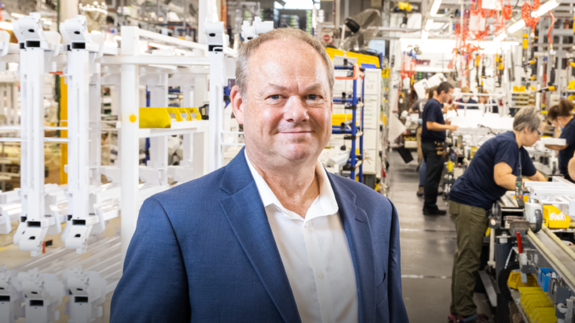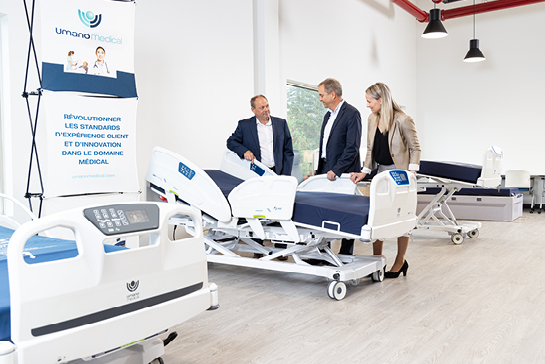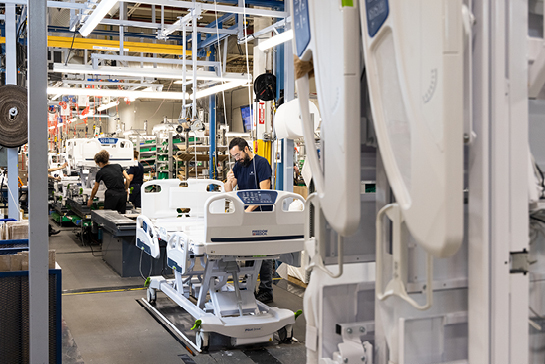Umano Medical: International success driven by innovation

Built-in precision scale, bed exit system, stability sensors, safety message centre, digital connectivity: the ook snow hospital bed line is much more about technology than furniture. Some models have several motors. They include just as many electronic boards, designed to help relieve nursing staff of numerous necessary but time consuming and repetitive patient-monitoring tasks.
At Umano Medical in two locations in L’Islet and Lévis (on the south shore of Quebec City), an impressive 75 out of 375 employees are dedicated to research and development. Robotization, digitization and connectivity are the key to their success and success in this industry.
Our growth is innovation based. Even with the best distribution network, you can only capture new market share with a product that really stands out
Robert Dion
Vice-President, Umano Medical
Hospitals and health systems prefer these connected, feature-packed beds because they make nurses’ daily work much easier giving them more time to manage patient needs in other ways. It’s also going to help attract and retain nursing staff, which are in short supply.
Innovation that supports health care personnel
“Our growth is innovation based. Even with the best distribution network, you can only capture new market share with a product that really stands out,” explains Robert Dion, the vice president of the company.
“We visited over 100 hospitals in North America to listen to clients and accurately target their needs. Even the name of our product is out of the ordinary. “Ook” refers to “ookpik,” the Inuit word for snowy owl and a symbol of Quebec. We chose “snow” because we fully own our northern culture in our approaches and values.”
Umano was founded by former employees of an American manufacturer that closed its Quebec plant in 2012 and relocated it to Mexico. The four partners bought the equipment and restarted production to keep jobs—and unique expertise—in the Quebec region.
The plan was to supply their former employer with specific parts for five years while investing in developing a new product line: the future ook snow beds. Then the plan derailed.
“We had the development expertise and agility of a small start-up. We were able to create the best product in the world, with a multinational company ready to market it under licence. But by late 2013, they lost interest in the project," says Dion. “So we decided to market the product ourselves. We had to build our distribution network from scratch.”

Staying true to their vision
The design and marketing of ook snow beds required steady investing for several years before any revenue could be expected. Of course, the track record and quality of Umano’s project could have convinced many deep-pocketed partners from Quebec and elsewhere. But this would have meant opening the company’s capital—which ran counter to the four partners’ original commitment to stay true to their vision through full control.
As a result, government assistance became the only way to “keep both hands on the wheel,” as Dion puts it.
“They all helped us with the financing, and by providing their advice and network of contacts,” he says.
Enter the BETR Team
Canada's trade team was set up by Ottawa to ensure federal agencies and crown corporations join forces to support Canadian businesses, specifically in their export activities.
Along with the Business Development Bank of Canada (BDC), other team members who supported Umano included:
- Export Development Canada (EDC)
- The Canadian Trade Commissioner Service (TCS)
- Canada Economic Development for Quebec Regions (DEC)
Several members have supported Umano since its inception. For example, EDC supported the initial stimulus package through loan guarantees. In 2015, the early days of marketing ook snow beds, the company relied on EDC’s credit insurance and the TCS CanExport SMEs program and took the United States and Brazilian markets by storm.
They all helped us with the financing, and by providing their advice and network of contacts.
Robert Dion
Vice-President, Umano Medical
Trade team members have also been there through thick and thin. In 2016, for instance, Umano’s main client realized that the new beds were generating serious competition. It filed a complaint with the US International Trade Commission (USITC). The case was settled in September 2016, after more than $3 million in legal fees—just when the company needed funds to fuel its growth.
This time, BDC Capital stepped in to help Umano maintain its momentum with cash flow financing. BDC also financed the company’s production facilities which was later expanded to meet demand. Meanwhile EDC continued to support Umano’s export efforts by providing additional financing. This minimized financing risk and provided much needed capital for Umano to continue their growth in the United Kingdom, Australia and Ireland.
“As of 2016, we experienced some pretty meteoric annual growth and quickly exceeded the $100 million in revenue we had originally set as a 10-year goal,” Dion says.
The Canadian Trade Commissioner Service supports Umano’s international expansion
Since 2013, the Canadian Trade Commissioner Service (TCS) has been supporting Umano as a client, providing free services and exporting advice for international business development in Asia, Europe and South America.
The TCS helped Umano prepare for their target markets, obtain funding for travel and other business development activities, and engage with pre-vetted international business contacts that would have been difficult for Umano to reach on its own.
TCS support has largely focused the company’s efforts to expand its exports from the United States to other countries, in particular Germany, Chile and Brazil.
For example, as a three-time recipient of CanExport SMEs funding, Umano was able to travel to Brazil and win multiple sales agreements. Trade Commissioners from Canada’s Consulate General in Sao Paulo and trade office in Recife, working with provincial partners such as the Bureau du Québec à São Paulo, supported Umano’s participation in trade shows and helped them make strategic connections in the country.
Ready for the post-pandemic era
But the arrival of COVID-19 really saw sales explode: they doubled in just three months. The challenge was no longer to deliver the right product, but to keep up with the pandemic demand.
“Throughout all of 2020–21, we have not had one week without a component shortage. Our suppliers are in Quebec but they source some electronic parts from Asia. We had to work hard to find substitutes or other solutions,” tells the co-founder.
Once again, government partners helped Umano take full advantage of the situation: the company received $2 million in working capital from BDC, $5 million in repayable contributions from Canada Economic Development for Quebec Regions.
The team's support was once again timely as the world’s health systems are being called to reassess their needs in the wake of the pandemic. A major player like Umano is well positioned to assist them.

No “wrong door” approach
Would you also like to benefit from the help of the Canada's trade team members? Contact BDC or any team member. We’ll lead the to the right destination.
